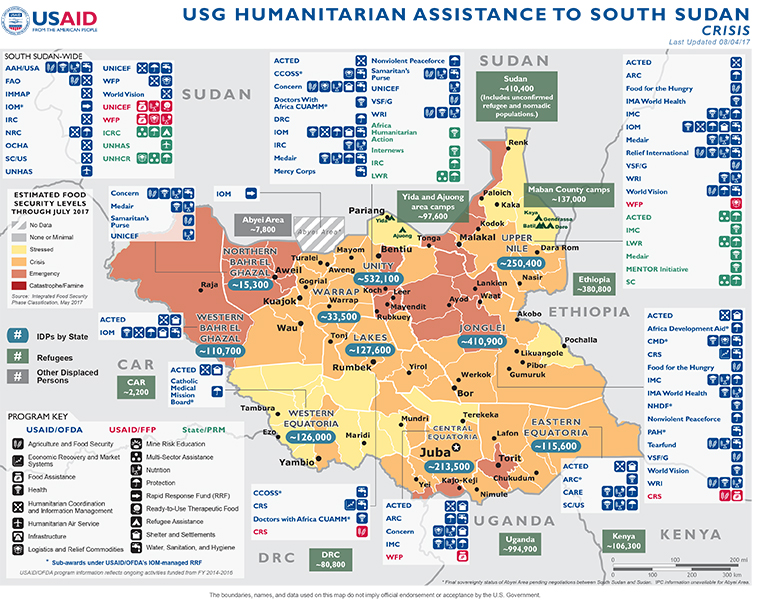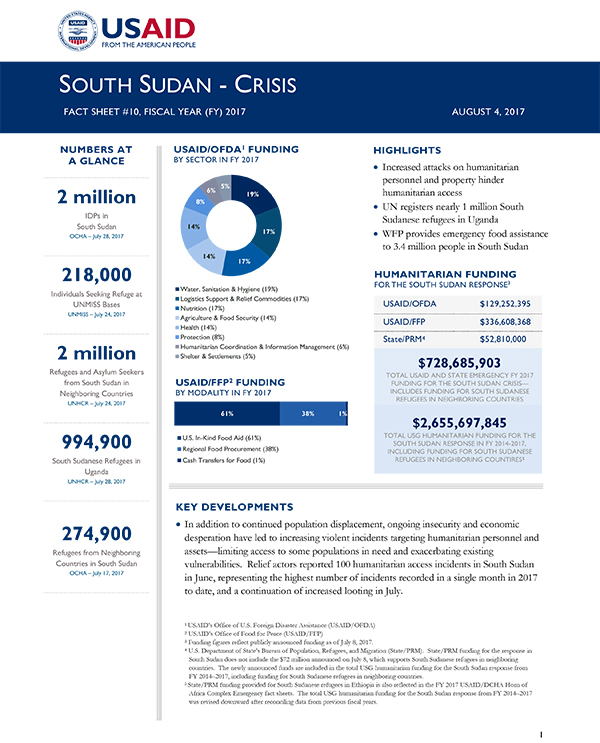- What We Do
- Agriculture and Food Security
- Democracy, Human Rights and Governance
- Economic Growth and Trade
- Education
- Ending Extreme Poverty
- Environment and Global Climate Change
- Gender Equality and Women's Empowerment
- Global Health
- Water and Sanitation
- Working in Crises and Conflict
- Disaster Assistance
- Political Transition Initiatives
- Conflict Mitigation and Prevention
- Countering Violent Extremism
- Disaster Risk Reduction
- Peacebuilding and Reconciliation
- Providing Safe & Secure Environments for Development
- Recovering From Crisis
- Resilience
- Tech Challenge for Atrocity Prevention
- World Humanitarian Day
- U.S. Global Development Lab
August 04, 2017
Highlights
- Increased attacks on humanitarian personnel and property hinder humanitarian access
- UN registers nearly 1 million South Sudanese refugees in Uganda
- WFP provides emergency food assistance to 3.4 million people in South Sudan
Key Developments
In addition to continued population displacement, ongoing insecurity and economic desperation have led to increasing violent incidents targeting humanitarian personnel and assets—limiting access to some populations in need and exacerbating existing vulnerabilities. Relief actors reported 100 humanitarian access incidents in South Sudan in June, representing the highest number of incidents recorded in a single month in 2017 to date, and a continuation of increased looting in July.
South Sudan Map - 08-04-2017 ![]() (pdf - 663k)
(pdf - 663k)
Numbers At A Glance
2 million
218,000
2 million
994,900
274,900
Humanitarian Funding
For the South Sudan Response
| USAID/OFDA | $129,252,395 |
| USAID/FFP | $336,608,368 |
| State/PRM | $52,810,000 |
Total USAID and State Emergency FY 2017 Funding for the South Sudan Crisis; Includes Funding for South Sudanese Refugees in Neighboring Countries: $728,685,903
Total USG Humanitarian Funding for the South Sudan Response in FY 2014-2017, Including Funding for South Sudanese Refugees in Neighboring Countires: $2,655,697,845
South Sudan Crisis Fact Sheet #10 - 08-04-2017 ![]() (pdf - 314k)
(pdf - 314k)
CURRENT EVENTS
More than 994,900 South Sudanese refugees have arrived in neighboring Uganda to date, according to the Office of the UN High Commissioner for Refugees (UNHCR). The UN agency expects the number to reach 1 million in the coming weeks given recent trends. In response to the continued influx of refugees into Uganda, humanitarian agencies are working to expand the Rhino Camp refugee settlement in Uganda’s Arua District, Northern Region, to receive new arrivals in early August. Recently arrived refugees report to UNHCR that the security situation in South Sudan continues to deteriorate, citing ethnically motivated attacks, gender-based violence (GBV), and forcible recruitment of youth by armed groups.
After releasing a report noting a 61 percent increase in GBV cases between 2015 and 2016, Amnesty International has called on government and opposition forces to cease acts of sexual violence and institute repercussions for GBV perpetrators. The advocacy organization has also encouraged the international humanitarian community to pressure parties to the conflict to end violations, increase public reporting of GBV instances, and expand health and protection services for survivors of GBV and other vulnerable populations. USAID/OFDA continues to support 11 humanitarian organizations providing standalone protection assistance, including GBV prevention and response, through more than $13 million in FY 2016 and FY 2017 funding.
INSECURITY, DISPLACEMENT, AND HUMANITARIAN ACCESS
On July 18, Government of the Republic of South Sudan (GoRSS) President Salva Kiir Mayardit declared a three-month state of emergency in areas of Northern Bahr el Ghazal, Warrap, and Western Bahr el Ghazal states. GoRSS officials contend that the declaration was made to improve security and end clashes between the Apuk and Aguok communities of the Dinka ethnic group that erupted in recent months. Mid-July fighting between the two groups resulted in at least 18 deaths, injured more than 30 people, and forced an unknown number of people to flee their homes in Warrap, according to local media.
Military forces loyal to GoRSS First Vice President (FVP) Taban Deng Gai announced the capture of Upper Nile State’s Maiwut town on July 27 following days of clashes, international media report. In late July, approximately 7,000 people fled fighting in Upper Nile’s Longochuk and Maiwut counties to neighboring Ethiopia; additional populations remain internally displaced in South Sudan, according to the UN. In response to escalating conflict in Upper Nile, relief organizations, including USAID partners, relocated at least 25 aid workers from the area in early July.
Tensions within the UN Mission in the Republic of South Sudan (UNMISS) protection of civilians (PoC) site in Unity State’s Bentiu town have prompted some internally displaced persons (IDPs) to leave the site, according to relief personnel. Camp management actors and community leaders are working together with UNMISS to defuse tensions and restore calm within the IDP community. Many of the IDPs who left the PoC site in recent weeks are sheltering in Unity’s Leer County and have integrated to host communities, humanitarian agencies report.
Relief actors reported 100 humanitarian access incidents in South Sudan in June, representing the highest number of incidents recorded in a single month in 2017, according to the UN. Approximately 51 percent of the incidents involved violence against humanitarian personnel, assets, or civilian infrastructure. In June, armed actors broke into at least 20 humanitarian compounds, looting supplies and personal belongings. Local authorities also reported at least 20 attacks on vehicles undertaking humanitarian missions. The UN reported that current trends indicate a rise in looting incidents in recent months, and the South Sudan Humanitarian Country Team noted a continuation of looting trends in July. Relief actors are working with local and national authorities to investigate the incidents, recover assets, and hold perpetrators accountable.
FOOD SECURITY AND NUTRITION
During June, USAID/FFP partner the UN World Food Program (WFP) reached approximately 2.8 million people in South Sudan with 27,000 metric tons (MT) of emergency food assistance, representing the highest number of people assisted in the country in one month since the beginning of the conflict. Between January and June 2017, WFP reached approximately 3.4 million—or nearly 30 percent of South Sudan’s pre-conflict population—with emergency food and nutrition assistance. Of this number, WFP assisted approximately 1.3 million individuals through 111 integrated rapid response mechanism (IRRM) missions. IRRM missions consist of teams of technical specialists from several humanitarian organizations who establish temporary humanitarian distribution sites in remote locations, allowing WFP to provide emergency food assistance to hard-to-reach populations in areas of the country inaccessible by road.
The UN Food and Agriculture Organization (FAO) has tracked fall armyworm (FAW) infestations since the pest was first reported in South Sudan in early June and reported FAW infestations in up to 10 counties to date. The infestations may reduce agricultural production and exacerbate existing food shortages in the country, according to international media. In addition to monitoring FAW infestations and conducting assessments, FAO is working with the GoRSS Ministry of Agriculture to develop a countrywide awareness campaign promoting effective response interventions and strengthening national pest surveillance systems.
With funding from USAID/OFDA, USAID/FFP, and USAID/South Sudan, Catholic Relief Services (CRS) supports livelihoods recovery and resilience activities to increase agricultural, fishing, and livestock production in food-insecure areas of Jonglei and Lakes states. Between October 2016 and June 2017, CRS facilitated the formation of approximately 80 agriculture, 60 fishery, and 10 livestock groups. During the same period, CRS distributed approximately 7,500 vegetable seed kits to farmers, nearly 5,400 fishing kits to fishery groups, and more than 6,800 tools—including hoes, rakes, and watering cans—to agriculture groups.
HEALTH
Between June 18, 2016, and July 30, 2017, health officials recorded 19,532 suspected cholera cases—including nearly 358 deaths—in South Sudan, representing a case fatality rate of approximately 1.8 percent, exceeding the UN World Health Organization (WHO) emergency threshold of 1 percent.
Health actors recorded more than 928,000 malaria cases and nearly 2,000 related deaths in South Sudan between January and June, according to the UN. Both cholera and malaria are endemic to the country, and cases typically increase during the May-to-September rainy season.
Ongoing conflict has resulted in the closure of many health facilities, and many remaining facilities are overcrowded due to simultaneous cholera and malaria outbreaks. Health organizations are scaling up malaria prevention and response activities, distributing mosquito nets, and replenishing anti-malarial medicines.
With funding from the USAID/OFDA-supported, International Organization for Migration (IOM)-managed Rapid Response Fund (RRF), the American Refugee Committee (ARC) began distributing approximately 97,000 doses of WHO-procured oral cholera vaccination to vulnerable populations in Eastern Equatoria State’s Kapoeta East County on August 2.
OTHER HUMANITARIAN ASSISTANCE
On July 30, the Government of the People’s Republic of China (GoPRC) announced a $1.8 million contribution to the GoRSS Ministry of Health, including $1 million toward cholera response activities and $800,000 in anti-malarial medications. The donation aims to strengthen GoRSS capacity to respond to simultaneous cholera and malaria outbreaks. In late July, the GoRSS also launched a GoPRC-funded expansion and modernization project of the Juba Teaching Hospital and the Kiir Mayardit Women’s Hospital in Lakes’s Rumbek town. In early 2017, GoPRC and GoRSS leaders had agreed to boost cooperation in the health sector by enhancing knowledge sharing, capacity building, and hospital to hospital collaborations.
CONTEXT
The January 2005 signing of the Comprehensive Peace Agreement (CPA) between the Government of Sudan and the southern-based Sudan People’s Liberation Army (SPLA) officially ended more than two decades of north–south conflict during which famine, fighting, and disease killed an estimated 2 million people and displaced at least 4.5 million others within Sudan.
The GoRSS declared independence on July 9, 2011, after a referendum on self-determination stipulated in the CPA. Upon independence, USAID designated a new mission in the capital city of Juba.
On December 15, 2013, clashes erupted in Juba between factions within the GoRSS and quickly spread into a protracted national conflict with Jonglei, Unity, and Upper Nile states representing the primary areas of fighting and displacement. On December 20, 2013, USAID activated a USAID Disaster Assistance Response Team (DART) to lead the USG response to the developing crisis in South Sudan. USAID also stood up a Washington, D.C.-based Response Management Team (RMT) to support the DART.
On August 26, 2015, GoRSS President Salva Kiir Mayardit signed a peace agreement that the Sudan People’s Liberation Army-In Opposition (SPLA-IO) and other stakeholders had signed on August 17. Opposition leader Riek Machar returned to Juba and was sworn in as FVP on April 26, 2016; GoRSS President Salva Kiir Mayardit appointed a Transitional Government of National Unity on April 28, 2016.
Fighting between SPLA and SPLA-IO forces broke out in Juba on July 7, 2016, displacing thousands of people and prompting FVP Machar to flee. As a result, the U.S. Embassy in Juba ordered the departure of non-critical USG personnel from South Sudan on July 10. Although ongoing heightened tensions persist in the country and the humanitarian situation remains precarious, the U.S. Department of State ended the ordered departure status for the U.S. Embassy in Juba on January 5, 2017.
Insecurity, landmines, and limited transportation and communication infrastructure restrict humanitarian activities across South Sudan, hindering the delivery of critical assistance to populations in need.
On October 14, 2016, U.S. Ambassador Mary Catherine Phee redeclared a disaster in South Sudan for FY 2017 due to the humanitarian crisis caused by ongoing violent conflict, resultant displacement, restricted humanitarian access, and the disruption of trade, markets, and cultivation activities, which have significantly increased food insecurity and humanitarian needs.
On February 20, the IPC Technical Working Group declared Famine levels of food insecurity in Leer and Mayendit. On June 21, the IPC Technical Working Group declared that sustained humanitarian interventions have moderately improved food security conditions in Unity’s Leer and Mayendit counties, resulting in the removal of the Famine level designation for acute food insecurity in the counties. However, life-threatening food insecurity continues to impact households across South Sudan, particularly in conflict-affected areas.









Comment
Make a general inquiry or suggest an improvement.